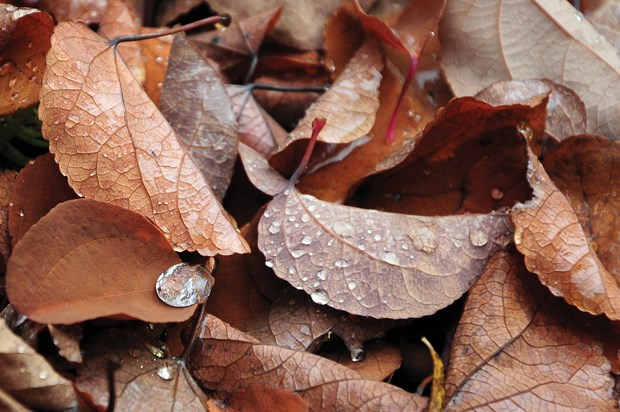Falling into November finds good work in the garden.
For gardeners it's not the end of the season, it's the beginning of a time of renewal, improvement and preparation. To those ends, here are some useful techniques for common fall gardening tasks.
Got leaves? Then you've got mulch.
Gone are the days when leaves were seen as refuse to be disposed of. In this age of sustainability, leaves are one of the most common renewable resources available. For those who don't like leaves as mulch, I urge you to give it a try. Prepare the leaves by running the lawn mower over them to shred them. This procedure makes the leaves visually palatable to the discerning eye. Don't bother shredding small leaves. They are pretty as they are. Spread the shredded or unshredded leaves onto the bed three to four inches thick up close to the base of all plants. Do not bury perennial crowns but mulch close. Don't forget to weed. Level and fluff as you go to get the best presentation. Water the new leaf mulch into place or let the rain do it.
I gotta move that plant.
Transplanting is one of the most basic skills every gardener should have. Dig a root ball that is proportionately sized to support the growth needs of the transplant. A rough, and I mean general, guideline for root ball digging size is six inches of root ball radius for every one inch of stem diameter. Avoid damaging the root ball during digging. Keep your feet off the root ball. Dig down into the soil uniformly around the root ball to attain a round shape. Dig to the bottom of the roots. Then dig under the root ball, cutting off roots as you go with an old pair of pruners. Once the entire ball is cut free from the earth, slide burlap or an equivalent material under the entire root ball. Once the burlap is completely under the root ball, lift the plant out of the earth and tie up the burlap tightly to hold the root ball together. Balled and burlapped plants - or BB, as they are known in the trade - can be stored until final planting but they must be watered and protected during storage. Covering the root ball with temporary protection, such as leaves or bark mulch, is recommended.
The perennials are falling down.
As they do during fall, perennials begin to look tired. For the healthiest perennials, keep the foliage growing until all or most of the green energy has been retracted from the leaves into root storage for winter. This gives the plant a good energy reserve for winter and next spring's growth. Once the leaves have turned colour, then cut back all foliage to the ground. Please, try to leave some flower heads standing for winter. Perennial seed heads are among the most beautiful in the plant kingdom and add interest to any garden in winter. Much depends on what perennials you grow. Not all perennials produce good winter seed heads or fruit. Beyond the visual, standing perennial seed heads also provide food for some birds and homes for beneficial insects.
Keeping up with the lawn.
If you ask professional turf managers they will tell you that fall is fertilizer time. It is important to remember that professional turf managers operate their lawns under a different set of performance objectives versus the needs of the average residential lawn owner. Only fertilize if your lawn is unhealthy and use a recommended fall fertilizer. But I think fall fertilization of lawns is generally a waste of money and environmentally damaging. For the home garden I do not recommend fall aeration unless you have an identifiable drainage or soil compaction problem. As for fall liming, it is recommended that lime be applied in fall as a general practice, but only for the purpose of using winter rains to wash the lime into intimate contact with the soil. Only apply lime if you test the soil pH to understand pH requirements, if any. Cutting lower in the fall has long been the grass mowing standard, which is useful for some grass species in sunny locations. Cutting lower may not be the best option if you have weed growth. Longer grass can outgrow many of the smaller weeds. Cutting length should generally be two to three inches tall. Topdressing in the fall is recommended to fill in bare spots and allow the grass to grow in full for winter. Use an organic topdress medium like manure or garden blend topsoil. Avoid the use of sand unless you buy sharp, angular, coarse grained sand. Playsand and other round sands are utterly useless in the garden for almost all uses.
What else? Plenty, but make time to feast your eyes on the colours of the season.



